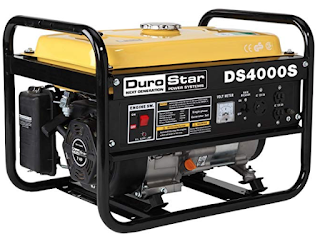The cost for back up power is very affordable starting around $260 for a highly rated DuroStar DS4000S that can run for 8 hours on 4 gallons of gas. At $2.00 per gallon, this is $1.00 per hour for electricity. This could save your food from spoiling in the refrigerator &/or freezer, and easily pay for itself in one power outage. Short of running a heater, air conditioner unit or an electric dryer, this 4,000 watt generator will power all of the important things in most homes. Here is a list of estimated power requirements.
Add to this, a cover (for the long periods where you hopefully don't need it) at a cost of $20 and an extra 14 gallon gas can that will run your generator for 28 hours. This is the first backup power system I would purchase.
Another option I actually prefer is the Champion 3800 Dual Fuel Generator which will run for 9 hours on its 3.4 gallon tank or 10.5 hours on a 20 pound Propane Tank, which is much safer to store and has an infinite shelf life vs the commonly used E10 gasoline (we put in our cars) which has a 8 to 12 month shelf life. This is about $0.76 per hour to run on gasoline and about $1.90 per hour for propane. Short of running a heater, air conditioner unit or an electric dryer, this 3,800 watt system will power all of the important things in most homes. Here is a list of estimated power requirements.
Granted the propane is more expensive but it is safer and has a much longer shelf life which could make it lower cost long term. I would keep propane stored for long term use, but use low cost gasoline while it was easily available.
A generator is affordable short term, but even the lowest operating cost option ($0.76/hour) becomes expensive long term, costing $550 per month for electricity and requiring regular trips to the gas station Solar power on the other hand requires a larger investment for equivalent power, but is cheaper to operate.
A wind generator in conjunction with a solar power system is actually the best combination for long term, sustainable power, that will continue to operate long after the gasoline supply is gone. When the sun isn't shining, the wind is probably blowing, providing a supply of electricity during the cloudy times, during the night and during the day.
Such a system might start with a Goal Zero Yeti 3000 Lithium Portable Power System for $2,400, as an addition to your generator system above. This is basically a big (280 amp hour) battery that can be charged by your homes power, your generator above while its providing power for your home, or by solar panels or a wind mill once there is no gasoline to run generators with. Fully charged, this will run your refrigerator for 50 hours. You can buy batteries at a much lower cost to build your own Starter Solar System, but this includes a lot of extras.
You can also run your Generator above for a few hours and charge this large battery to use during the rest of the day, extending your Generator fuel for potentially weeks.
For $575 you can add 200 watts of portable Goal Zero Solar Panels specifically designed for this battery power pack. It is pre-wired and ready to go by plugging one connector in. This 200 watt system will run your refrigerator, an LED light and a box fan. Here is a list of estimated power requirements.
The addition of 8 Solar panels for $2,500 will keep this battery charged and provide 800 watts of 12 VDC power for each hour of sun shine. This 800 watt system will run a refrigerator, freezer, LED lights, radio, charge your phones and more. Here is a list of estimated power requirements.
A 2000 Watt Wind Mill for $750 will top off your system and provide a more balanced supply of power, even during cloudy days or at night. Add this to the 8 panels above and you can power all of the important things in most homes, indefinitely. Note that the 800 watt solar system generates up to 800 watts when the sun is fully shining, and the 2,000 watt wind mill generates up to 2,000 watts when the wind is blowing hard. Figuring a maximum of 50% on both system is reasonable when sunny and windy. So on a windy sunny day, you might expect about 1,400 watts of power supply. Here is a list of estimated power requirements.
For more information:
Blog Table of Contents
Power Outage Preps
Power Outage Heater
EMP Survival
The SHTF Day One
Survive a 2 week Power Outage
Complete Sustainable Living Plan
Backup Power Supply
Backup Power for Under $50







No comments:
Post a Comment
Note: Only a member of this blog may post a comment.